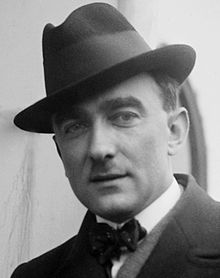Karol Szymanowski | |
|---|---|
 Szymanowski in 1922 | |
| Born | Karol Maciej Szymanowski 3 October 1882 Tymoszówka, Russian Empire |
| Died | 29 March 1937 (aged 54) Lausanne, Switzerland |
| Works | List of compositions |
Karol Maciej Szymanowski (Polish pronunciation: [ˈkarɔl ˈmat͡ɕɛj ʂɨmaˈnɔfskʲi]; 3 October 1882 – 29 March 1937)[a][1] was a Polish composer and pianist. He was a member of the modernist Young Poland movement that flourished in the late 19th and early 20th century.
Szymanowski's early works show the influence of the late Romantic German school as well as the early works of Alexander Scriabin, as exemplified by his Étude Op. 4 No. 3 and his first two symphonies. Later, he developed an impressionistic and partially atonal style, represented by such works as the Third Symphony and his Violin Concerto No. 1. His third period was influenced by the folk music of the Polish Górale people, including the ballet Harnasie, the Fourth Symphony, and his sets of Mazurkas for piano. King Roger, composed between 1918 and 1924, remains Szymanowski's most popular opera. His other significant works include Hagith, Symphony No. 2, The Love Songs of Hafiz, and Stabat Mater.
Szymanowski was awarded the highest national honors, including the Officer's Cross of the Order of Polonia Restituta, the Order of Merit of the Republic of Poland and other distinctions, both Polish and foreign.[2]
Cite error: There are <ref group=lower-alpha> tags or {{efn}} templates on this page, but the references will not show without a {{reflist|group=lower-alpha}} template or {{notelist}} template (see the help page).